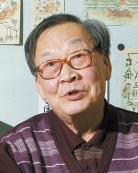An artist traces the Korean War

Kim Song-hwan
Things were not always so comfortable. His pen name “Gobau (Strong Rock) came to him in the summer of 1950, when, as an 18-year-old, he was hiding out from North Korean troops amid the chaos of the Korean War. A high school student and part-time magazine illustrator (“We had cameras, but printing was not so good; photos often came out black!”) living just outside Seoul at the time of North Korea’s June 25, 1950 invasion, he recorded the dramatic events of those days with a blend of delicate Oriental watercolor work and the sensitive pen cartoons that would later become his trademark.
After Seoul’s September 1950 liberation, he was hired as a war artist by the Ministry of Defense, but it is his early works that capture what it was like to be a civilian on the peninsula in the midst of total war that are the most affecting.
On the 59th anniversary of Kim Il Sung’s blitzkrieg, the JoongAng Daily presents a selection of Gobau’s works - with comments from the master - from those first, seesawing months of the war.
By Andrew Salmon Contributing writer [estyle@joongang.co.kr]
Photo slideshow










with the Korea JoongAng Daily
To write comments, please log in to one of the accounts.
Standards Board Policy (0/250자)